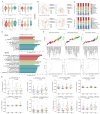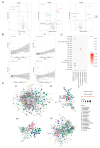Unique Microbial Characterisation of Oesophageal Squamous Cell Carcinoma Patients with Different Dietary Habits Based on Light Gradient Boosting Machine Learning Classifier
- PMID: 40284204
- PMCID: PMC12030675
- DOI: 10.3390/nu17081340
Unique Microbial Characterisation of Oesophageal Squamous Cell Carcinoma Patients with Different Dietary Habits Based on Light Gradient Boosting Machine Learning Classifier
Abstract
Objectives: The microbiome plays an important role in cancer, but the relationship between dietary habits and the microbiota in oesophageal squamous cell carcinoma (ESCC) is not clear. The aim of this study is to explore the complex relationship between the microbiota in oesophagal tissue and dietary habits in ESCC patients. Methods: 173 ESCC patients were included. The method of 16S rRNA sequencing was used to analyze microbial composition and diversity. The LEfSe and Boruta methods were used to screen important microbes, and the LightGBM algorithm distinguished microbes associated with different dietary habits. PICRUST2 and DESeq2 predicted microbial function and screened differential functions. The Pearson test was used to analyze correlations between microbes and functions, and SPARCC microbial symbiotic networks and Cytoscape were used to determine microbial interactions. Results: Significant differences in microbial composition were observed among ESCC patients with different dietary habits. LEfSe and Boruta identified three, six, and two significantly different bacteria in the FF/FP, FF/PF, and FF/PP groups, respectively, with AUC values of 0.683, 0.830, and 0.715. PICRUST2 and DESeq2 analysis revealed 3, 11, and 5 significantly different metabolic pathways in each group. Eubacterium_B sulci was positively correlated with PWY-6285, PWY-3801, and PWY-5823. PWY-6397 was positively correlated with undefinded (Fusobacterium_C). Microbial network analysis confirmed unique microbial characteristics in different diet groups. Conclusions: Different dietary habits lead to alterations in Eubacterium_B sulci and undefinded (Fusobacterium_C) and related functional pathways.
Keywords: LightGBM; diet; microorganisms; oesophageal squamous cell carcinoma.
Conflict of interest statement
The authors declare no conflicts of interest.
Figures


Similar articles
-
Association between alcohol consumption and oesophageal microbiota in oesophageal squamous cell carcinoma.BMC Microbiol. 2021 Mar 6;21(1):73. doi: 10.1186/s12866-021-02137-x. BMC Microbiol. 2021. PMID: 33673801 Free PMC article.
-
Combining fecal microbiome and metabolomics reveals diagnostic biomarkers for esophageal squamous cell carcinoma.Microbiol Spectr. 2024 May 2;12(5):e0401223. doi: 10.1128/spectrum.04012-23. Epub 2024 Mar 18. Microbiol Spectr. 2024. PMID: 38497715 Free PMC article.
-
Oral Microbiome in Patients with Oesophageal Squamous Cell Carcinoma.Sci Rep. 2019 Dec 13;9(1):19055. doi: 10.1038/s41598-019-55667-w. Sci Rep. 2019. PMID: 31836795 Free PMC article.
-
Upper gastrointestinal tract microbiota with oral origin in relation to oesophageal squamous cell carcinoma.Ann Med. 2023;55(2):2295401. doi: 10.1080/07853890.2023.2295401. Epub 2023 Dec 27. Ann Med. 2023. PMID: 38151037 Free PMC article. Review.
-
The role of microbiota in esophageal squamous cell carcinoma: A review of the literature.Thorac Cancer. 2023 Oct;14(28):2821-2829. doi: 10.1111/1759-7714.15096. Epub 2023 Sep 7. Thorac Cancer. 2023. PMID: 37675608 Free PMC article. Review.
References
-
- Ferlay J., Ervik M., Lam F., Laversanne M., Colombet M., Mery L., Piñeros M., Znaor A., Soerjomataram I., Bray F. Global Cancer Observatory: Cancer Today. International Agency for Research on Cancer; Lyon, France: 2024. [(accessed on 6 April 2025)]. Available online: https://gco.iarc.who.int/today.
-
- Fackelmann G., Manghi P., Carlino N., Heidrich V., Piccinno G., Ricci L., Piperni E., Arrè A., Bakker E., Creedon A.C., et al. Gut Microbiome Signatures of Vegan, Vegetarian and Omnivore Diets and Associated Health Outcomes across 21,561 Individuals. Nat. Microbiol. 2025;10:41–52. doi: 10.1038/s41564-024-01870-z. - DOI - PMC - PubMed
MeSH terms
Substances
LinkOut - more resources
Full Text Sources
Medical
Miscellaneous

